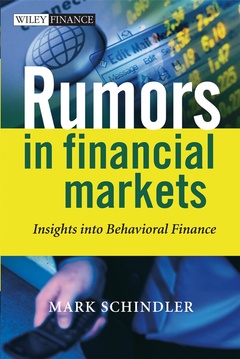Description
Rumors in financial markets : Insights into behavioral finance
Insights into Behavioral Finance
The Wiley Finance Series, Vol. 391
Author: Schindler Mark
Language: English
Subject for Rumors in financial markets : Insights into behavioral...:
Approximative price 83.62 €
Subject to availability at the publisher.
Add to cart
Publication date: 03-2007
196 p. · 16.8x24.6 cm · Hardback
196 p. · 16.8x24.6 cm · Hardback
Description
/li>Contents
/li>Biography
/li>
A real-world look at the effect of rumor in the financial markets Rumors in Financial Markets provides fresh insight on the topic by combining the theories of behavioral finance and experimental finance-a new and revolutionary scientific method for observing real decisions (and those who make them) in a controlled and structured environment.
List of symbols. Preface. 1 Introduction. 1.1.Objectives of this book. 1.2.Structure of this book. 1.3.Research methodology. 2 Definitions and Characteristics of Rumors. 2.1 Definitions. 2.1.1 Structure of the categories news, information and rumor. 2.1.2 Rumors versus Gossip. 2.1.3 Summary of rumor characteristics. 2.2 Historical background of studies on rumors. 3 Rumors and the Theory of Finance. 3.1.Rumors and Behavioral Finance. 3.1.1 Theoretical excursion: A formal definition of the value of information. 3.1.2 The relationship between the value of information and efficient markets. 3.1.3 The criticisms of Behavioral Finance. 3.1.4 The link between rumors and Behavioral Finance. 3.1.5 Financial markets as a fruitful ground for rumors. 3.1.6 Six types of rumors. 3.1.7 Classification of rumors in financial markets. 3.2.Rumors and rational behavior. 3.2.1 Rationality in the classical Theory of Finance. 3.2.2 Bounded rationality. 3.2.3 Procedural rationality. 3.2.4 An action is always rational. 3.2.5 Rationality in financial markets. 3.3.Empirical studies of rumors in the stock market. 3.4.Review of models on rumors. 3.5. Ethnographical studies. 4 Legal Aspects of Rumors in Financial Markets. 4.1.Rumors in financial markets and insider trading. 4.1.1 Introduction. 4.1.2 Review of scientific literature on insider trading. 4.2.Review of models on insider trading. 4.2.1 Models of insider trading regulation. 4.2.2 Models of trading by registered insiders. 4.3.Rumors in financial markets and price manipulation. 4.4.Review of models on market manipulation. 5 Survey of Rumors in Financial Markets. 5.1.The survey and its intention. 5.2.Participant profile. 5.2.1. Survey parameters. 5.2.2. Survey participants. 5.3. Evolvement of rumors. 5.3.1. How rumors start and why. 5.3.2. Correlation between market volatility and frequency of rumors. 5.3.3. What is the source? 5.3.4. First actions on a rumor. 5.3.5. Action on specific vs. general rumors. 5.4.Spreading of rumors. 5.4.1. To spread or not to spread? 5.4.2. First or last in the row? 5.4.3. Spreading time: How long it takes. 5.5.Belief in rumors. 5.5.1. Why rumors are believed. 5.5.2. Does it matter what you believe? 5.6.Network formation. 5.7.Trading on rumors. 5.7.1. Systematic price patterns? 5.7.2. Rumor sources and profits. 5.7.3. Thoughts triggered by the price movement. 5.7.4. Actions triggered by the price movement. 5.8.Rumors vs. information. 5.8.1. Trading on rumors vs. trading on information. 5.8.2. The difference between a rumor and information. 5.9. Conclusions from the survey. 5.9.1. Rumors follow logical rules. 5.9.2. Prices reflect beliefs. 5.9.3. Investment strategies on rumors. 5.9.4. Relating the results to other studies. 6 Rumors Experiments. 6.1.Why experiments as a research methodology? 6.2. Methodological pre-considerations. 6.2.1. Internal vs. external validity. 6.2.2. Selection of participants. 6.2.3. Payment of participants. 6.3.Review of previous rumor experiments. 6.3.1. The psychological experiments of DiFonzo and Bordia. 6.3.2. An economic approach towards rumor experiments and their structuring in this book. 6.4.First stage experiments: Ambiguity aversion in a financial market. 6.4.1. A brief overview of ambiguity aversion. 6.4.2. Experimental design. 6.4.3. Results of the first stage experiments. 6.4.4. Discussion. 6.4.5. Conclusion. 6.5.Second stage experiments: Varying rumor messages. 6.5.1. A brief discussion of the existing literature. 6.5.2. Experimental design. 6.5.3. Results of the second stage experiments. 6.5.4. Conclusion. 6.6.Third stage experiments: Testing herding behavior. 6.6.1. A brief overview of herding behavior in financial markets. 6.6.2. Experimental design. 6.6.3. Results of the third stage experiments. 6.6.4. Discussion and conclusion. 6.7.Fourth stage experiments: Communication. 6.7.1. A brief overview. 6.7.2. Experimental design. 6.7.3. Results of the fourth stage experiments. 6.7.4. Discussion and conclusion. 7 Conclusions and Outlook. Appendix. Appendix I: Appendix I.1: Formal presentation of preference relations and choice rules. Appendix II: Appendix II.1: Experimental instructions for the rumor setting with an auctioneer (experiments 1 and 2). Appendix II.2: Experimental instructions for the rumor setting with a batch auction (experiments 3 and 4). Appendix II.3: Experimental instructions for the rumor setting in a continuous double auction (experiments 5 to 12). Appendix III: Appendix III.1: Second stage experimental instructions. Appendix IV: Appendix IV.1: Third stage experimental instructions. Appendix V: Appendix V.1: Fourth stage experimental instructions. Appendix V.2: First two message levels. Notes. Bilbiography.
Mark Schindler has written his PhD on "Rumors in Financial Markets" at the Institute for Empirical Research in Economics at the University of Zurich under the supervision of Prof. Thorsten Hens and Prof. Ernst Fehr. Formerly he was working for Arthur Andersen in the area of Financial and Commodities Risk Consulting. He is currently a Funds of Hedge Funds manager for Bank Leu in Zurich.
© 2024 LAVOISIER S.A.S.
These books may interest you

The Psychology of Investing 222.92 €

The Psychology of Investing 80.69 €


